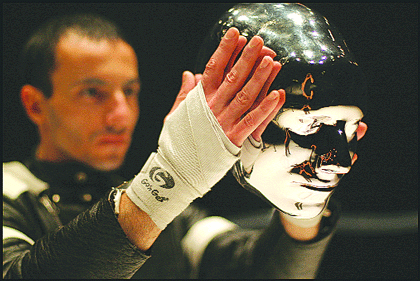A culture of transience grows global
The millennium has come and gone with no apocalypse, and nary a horseman in sight. Still, beneath the blissful glow of globalization, a culture rife with suicide, school shootings, and hatred festers—to say nothing of the young warriors and insurgents initiated since 9/11. Violence wins. Death rules.
Rachid Ouramdane embodies these ideas quite literally in “Discreet Deaths,” a solo that reflects on the imagery of teen suicide, the death penalty, goth culture, suicide bombers, prescription drugs, and pop music. Its genesis stems from Ouramdane’s Internet search of “[The] Young Man [and] Death.” He was looking for information on the 1946 ballet created by Roland Petit and Jean Cocteau; what he found was a torrent of chat rooms, sites, and blogs about suicide—a popular culture obsessed with its own death.
On stage, in a kind of boxing ring fashioned from three flat screen video panels connected by transparent tubes, coursing with red and blue liquids, Ouramdane portrays these desperate and self-destructive identities with disaffected truth, sometimes in barefeet, jeans, and white T-shirt; others in a motorcycle jacket, or a mask. Found and created images and sequences circulate on the screens, deteriorate, and roll horizontally, like on an old TV set. Iraq war reports, Marilyn Manson, Bach, and Arabic melodies are among the audio elements used.
“The work I am doing is mainly questioning the issue of identity and being part of a minority identity,” said Ouramdane in a recent interview.
“The work tries to show the identity of somebody made by many mixed identities because of their mixed cultural heritage.”
The son of Algerian parents who grew up in a French housing estate, Ouramdane studied dance in New York and has performed here with Meg Stuart, but the performances at DTW mark the U.S. debut of his work.
Ouramdane’s presence on stage is chillingly focused. He dances with a toddler crash test dummy, using his feet, and it is as touching as odd. To Manson’s angry version of “Tainted Love” he moves as if his insides are exploding, as if his soul were shattering, leaving just the spasmic husk. He plays boxer, biker, believer—and bomber.
While that last is an unsettling reference, “it is not an act of violence, not an espousal of violence,” said Cathy Edwards, artistic director of DTW. “This work is a meditation on the range of violence of being a young man in the world. We see these images everyday, young men caught at the border. That is just one in a series of images that he cycles through, or tries on for size. It has no more value than the man in the boxing ring, or the man in the motorcycle jacket.”
“I am curious to come to the U.S. especially at this moment, especially with this project,” said Ouramdane. “It is a reflection in the relations between North and South, Arabic culture in contact with a more Occidental, Western one. The U.S. is so involved in Arabic culture now, through war. We are dealing with death in many different cultures, in many different countries. It makes us part of a certain community. It is a base instinct that we join around.”
gaycitynews.com


































